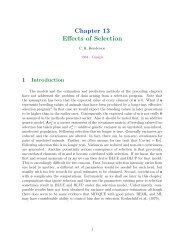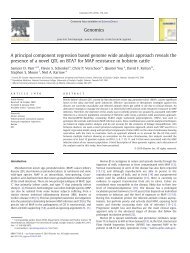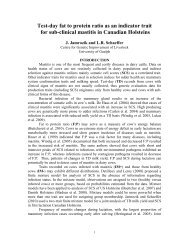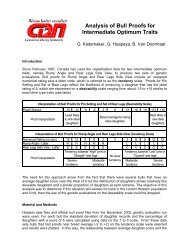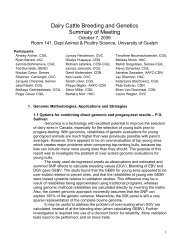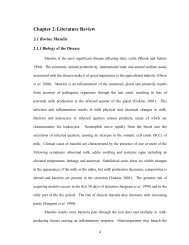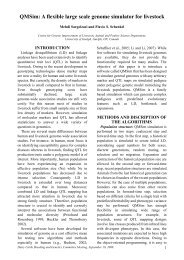Strain and maturation effects on female spawning time in diallel ...
Strain and maturation effects on female spawning time in diallel ...
Strain and maturation effects on female spawning time in diallel ...
You also want an ePaper? Increase the reach of your titles
YUMPU automatically turns print PDFs into web optimized ePapers that Google loves.
108<br />
Evidence for n<strong>on</strong>-additive genetic <str<strong>on</strong>g>effects</str<strong>on</strong>g> <strong>on</strong> ra<strong>in</strong>bow trout growth has been found (Gall<br />
<str<strong>on</strong>g>and</str<strong>on</strong>g> Huang, 1988a; Su et al., 1996b; Pante et al., 2001), but at this <strong>time</strong> no c<strong>on</strong>clusi<strong>on</strong>s can<br />
be made about n<strong>on</strong>-additive genetic <str<strong>on</strong>g>effects</str<strong>on</strong>g> <strong>on</strong> <strong>spawn<strong>in</strong>g</strong> <strong>time</strong>. In the sole <strong>in</strong>cidence of<br />
heterosis (between WC <str<strong>on</strong>g>and</str<strong>on</strong>g> OC stra<strong>in</strong>s at 3 years old), there was <strong>on</strong>ly a small difference<br />
between hybrid <str<strong>on</strong>g>and</str<strong>on</strong>g> pure stra<strong>in</strong> performances, <str<strong>on</strong>g>and</str<strong>on</strong>g> other <strong>in</strong>ternal factors could have<br />
c<strong>on</strong>tributed to this difference. If an <strong>in</strong>dividual <strong>female</strong> must reach some threshold body size<br />
<strong>in</strong> order to spawn <strong>in</strong> a given seas<strong>on</strong>, those just <strong>on</strong> this threshold may have delayed oocyte<br />
development <str<strong>on</strong>g>and</str<strong>on</strong>g> ovulati<strong>on</strong> <strong>in</strong> their maiden seas<strong>on</strong>. This delayed <strong>spawn<strong>in</strong>g</strong> would be seen<br />
particularly <strong>in</strong> the early-<strong>spawn<strong>in</strong>g</strong> OC OC 3 year maiden spawners (as compared with<br />
other stra<strong>in</strong>s that spawned later <strong>in</strong> the year). When size or growth rate was no l<strong>on</strong>ger a<br />
factor at 4 years of age, the average spawn date of the hybrids was the same as the average<br />
spawn date of the pure stra<strong>in</strong>s.<br />
Inbreed<strong>in</strong>g <strong>in</strong> the WC or OC stra<strong>in</strong>s could also have caused changes <strong>in</strong> spawn date,<br />
similar to results found by Su et al. (1996a) who reported that <strong>in</strong>bred <strong>female</strong>s spawned at a<br />
later age. Any <strong>in</strong>breed<strong>in</strong>g effect would be removed by cross<strong>in</strong>g with different stra<strong>in</strong>s,<br />
therefore result<strong>in</strong>g <strong>in</strong> heterosis. There were, however, no heterosis <str<strong>on</strong>g>effects</str<strong>on</strong>g> when these<br />
stra<strong>in</strong>s were crossed with MG, so it is unlikely that removal of <strong>in</strong>breed<strong>in</strong>g depressi<strong>on</strong><br />
caused the heterosis effect.<br />
There were also differences for <strong>spawn<strong>in</strong>g</strong> performances between reciprocal crosses.<br />
Hybrids’ spawn dates tended to be more similar to that of their dam’s stra<strong>in</strong> than that of their<br />
sire’s stra<strong>in</strong>, as shown by the order of <strong>spawn<strong>in</strong>g</strong> A A, A B, B A, B B <strong>in</strong> all crosses.<br />
Hybrids from an early-<strong>spawn<strong>in</strong>g</strong> dam stra<strong>in</strong> spawned earlier than those hybrids that had the<br />
same stra<strong>in</strong> as their sire. In species that rear their young, differences between reciprocal<br />
crosses usually represent differences <strong>in</strong> maternal ability (Van Vleck et al., 1987), however,<br />
ra<strong>in</strong>bow trout do not rear their young. These results suggest that some other maternal factor<br />
affected spawn date. In this case, the <strong>spawn<strong>in</strong>g</strong> date of the dam, which was c<strong>on</strong>founded with<br />
dam stra<strong>in</strong>, could have c<strong>on</strong>tributed to differences between reciprocal crosses. No other<br />
studies <strong>on</strong> <strong>spawn<strong>in</strong>g</strong> <strong>time</strong> <strong>in</strong> reciprocal crosses have been published. Further research is<br />
needed to determ<strong>in</strong>e if n<strong>on</strong>-additive genetic or maternal <str<strong>on</strong>g>effects</str<strong>on</strong>g> c<strong>on</strong>trol this trait.<br />
4.3. Maturati<strong>on</strong> year <str<strong>on</strong>g>effects</str<strong>on</strong>g><br />
At 4 years of age, repeat spawners (<strong>female</strong>s that had matured at 3 years of age, <str<strong>on</strong>g>and</str<strong>on</strong>g> were<br />
<strong>spawn<strong>in</strong>g</strong> for the sec<strong>on</strong>d <strong>time</strong>) spawned earlier than maiden spawners. This result may<br />
relate to the previously-discussed idea that <strong>spawn<strong>in</strong>g</strong> at 3 years of age may be delayed <strong>in</strong><br />
<strong>female</strong>s that are close to a threshold body size. By the <strong>time</strong> these <strong>female</strong>s repeat <strong>spawn<strong>in</strong>g</strong><br />
at 4 years of age, eggs have had more <strong>time</strong> to ripen, <str<strong>on</strong>g>and</str<strong>on</strong>g> ovulati<strong>on</strong> can occur earlier. It<br />
would have been <strong>in</strong>terest<strong>in</strong>g to observe if this trend c<strong>on</strong>t<strong>in</strong>ued <strong>in</strong> subsequent <strong>spawn<strong>in</strong>g</strong><br />
seas<strong>on</strong>s, but this was bey<strong>on</strong>d the scope of the current project.<br />
4.4. Repeatability<br />
C.D. Qu<strong>in</strong>t<strong>on</strong> et al. / Aquaculture 234 (2004) 99–110<br />
Repeatability estimates of spawn date were high; therefore, <strong>female</strong>s that spawned early<br />
<strong>in</strong> the seas<strong>on</strong> at 3 years of age also tended to spawn early <strong>in</strong> the seas<strong>on</strong> at 4 years of age.<br />
Similarly, fish that spawned late <strong>in</strong> the seas<strong>on</strong> at 3 years of age also tended to spawn late <strong>in</strong>





